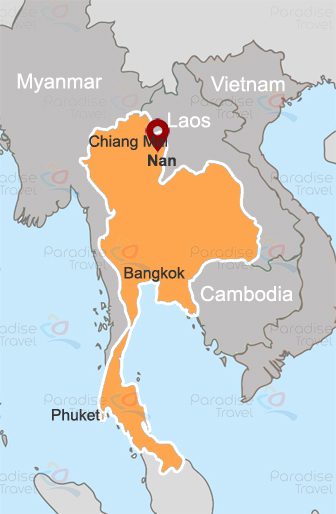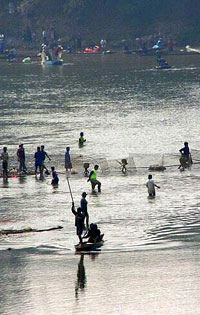Nan Travel Guide
 Nan or Muang Nan is framed in a verdant valley located in Northern Thailand about 668 kilometers north of Bangkok and approximately 320 kilometers east of Chiang Mai. Its stillness and peaceful environment provide an escape from everything. Nan is a tranquil and quiet province comprised of many districts, all of which give offers an attractive scenic of rural Thailand. Nan is situated near the border with the Nan River one of the large tributaries of the Chao Phraya River.
Nan or Muang Nan is framed in a verdant valley located in Northern Thailand about 668 kilometers north of Bangkok and approximately 320 kilometers east of Chiang Mai. Its stillness and peaceful environment provide an escape from everything. Nan is a tranquil and quiet province comprised of many districts, all of which give offers an attractive scenic of rural Thailand. Nan is situated near the border with the Nan River one of the large tributaries of the Chao Phraya River.
Nan goes back to the depths of the history of Thailand. Nan natives descend from the Lan Changs (Laotians). Nan was, for centuries, an autonomous kingdom, by the end of the 14th century was part of Lanna Kingdom; Burmese took control of Nan in 1558 and finally at the beginning of the 20th century was incorporated into Thailand.
The city itself is small with some charm; the city spreads out along around 4 kilometers. Inside the city, three bridges connect both banks of the Nan River: the Sriboonruang Bridge, the Pattana Paknue Bridge, and the Nakorn Nan Pattana Bridge. Mahayot Road and Sumonthewarat Road are the main roads of the city, the main monuments of the city can be found near Pha Kong Road, Mahayot Road, Sumonthewarat Road and Suriyapong Road. The main shops are located along the Sumonthewarat Road and Anantaworattidet Road. Nan City can be explored on foot during the cooler hours of the day.
Nan is popular for its hospitality standards, good restaurants, bars and accommodation facilities. Nan is home of numerous hill tribes who retain its customs and traditions, such art objects which women and children make in their homes. The city has a pleasant riverfront area. Nan possesses fascinating geographical sites, is home to six national parks, boosting it as an excellent alternative trekking location, the cost is usually bit pricier but the experience will fill nature lovers with enthusiasm.
The town possesses important temple sites, rich museums and some fascinating historical sites such as the Nan National Museum, Wat Suan Tan, Wat Phra That Khao Noi, Wat Phumin, Pha Toob Arboretum, Pha Tup Forest Park, Phumin Village, The House of Chao Fongkham, King of Nan’s Teak House and The Old Wall, other worth seeing sites are: Wat Chang Kham, located in the heart of Nan City and constructed in 1426; there are Buddha images (including a Golden Buddha Image of 145 cm), elephants sculptures and more.

Phra That Chae Haeng, located just outside Nan, is an over 600-year-old community, was constructed in the Sukhothai Period. The annual worshipping fair takes place here, the fair includes fireworks processions and offerings processions. Kat Laeng is an evening market situated on the bank of the Nan River. Traditional Thai handicrafts, souvenirs, and various types of products are on sale at bargain prices.
Nan is famous for its annual boat race, held in October or November when the water level is at its peak. The race is part if the celebrations of the Black Ivory and the local Kathin ceremony. Its beginning can be traced back to Ayutthaya period, some 600 years ago.
